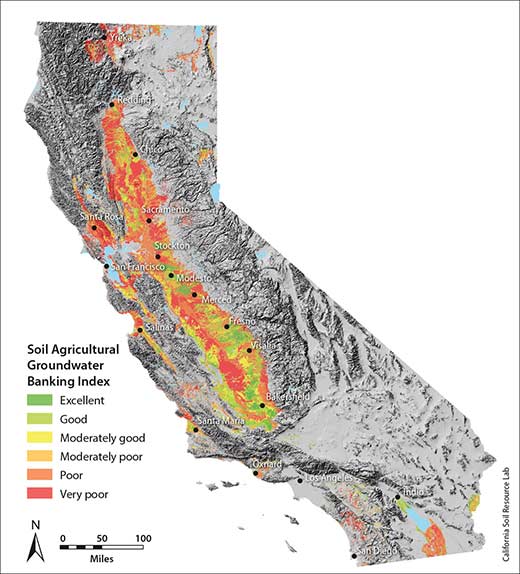
This map is part of the Soil Agricultural Groundwater Banking Index, which identifies farmlands with the most potential to capture groundwater and help recharge groundwater.
Image from UC Davis
This winter, some California farmers will be flooding their fields to replenish groundwater. El Niño is expected to deliver a warmer, wetter winter season to California, and farmers are hoping to capitalize on the extra water by directing floodwater and stormwater to their fields. The water will percolate through the soil and into the aquifer below, raising the water table and reducing the costs of pumping water for irrigation the following summer.
In some parts of California, water tables have plummeted by more than 30 m (100 ft), as growers and others dig wells deeper into the earth to replace diminishing surface-water supplies. To solve this problem, irrigation districts have tried building infiltration basins on sandy farmland. Yet, this has not been enough to solve groundwater overdraft during California’s record-breaking drought.
However, as many as 1.46 million ha (3.6 million ac) of California farmland could be used to recharge groundwater, according to researchers with the University of California (UC) Cooperative Extension and UC Davis. Due to their soils, topography, and crop type, these lands could likely accommodate groundwater banking with little risk of crop damage or groundwater contamination. The researchers also developed an interactive map where growers can obtain site-specific information on the suitability of soils for on-farm recharge.
“On-farm flooding looks very promising,” said Professor Helen Dahlke, a hydrology expert with the UC Davis Department of Land, Air and Water Resources. “We’re pleasantly surprised by how quickly water tables have responded to on-farm flooding without damage to crops.”
In spring 2015, Dahlke’s team flooded alfalfa at Bryan-Morris Ranch in Siskiyou County, applying more than twice the irrigation the field normally gets in a year. The field produced more weeds than usual, but otherwise, the alfalfa suffered no ill effects.
“It was amazing to see how well the land absorbed the water and how quickly the water table rose,” said Jim Morris, Bryan-Morris Ranch manager. “That’s good news for farming and the environment.”
Dahlke and her team will test flooding on almonds in the Central Valley this winter, looking at plant physiology, infiltration rates, water quality, and costs. They are building on previous research involving UC Davis and environmental engineers in the Kings River Basin, where up to 75% of diverted floodwater percolated down to aquifers. In that research, scientists flooded pistachios, alfalfa hay, and wine grapes.
“Our wine grapes were under water for five months, which raised a few eyebrows, but they did fine,” said Don Cameron, manager of Terranova Ranch along the Kings River in Fresno County. “Diverting floodwater to farms can recharge groundwater and reduce the risk of downstream flooding. It’s a good situation all around.”
The California nonprofit Sustainable Conservation has been involved with the groundwater recharge pilot project on Terranova Ranch since 2011. The project evaluated the benefits of capturing winter and spring floodwaters from the lower Kings River. According to Sustainable Conservation, the team flooded an area the size of 756 football fields and filled each field with water approximately 914 mm (3 ft) deep without affecting crop yields.
Sustainable Conservation has partnered with other growers in the San Joaquin Valley on field trials to accelerate groundwater recharge on agricultural land. And in October, the group announced a partnership with the Almond Board of California to explore recharging groundwater on California’s one million acres of almond orchards. As part of this partnership, Sustainable Conservation, UC researchers, and other specialists will determine how floodwater can be best applied on almond orchards to protect both groundwater quality and crops.
This is still a new concept, and there are questions to answer, including: who owns rights to floodwater; how will this affect certain crops; and could this mobilize nitrates or other pollutants and contaminate groundwater?
However, flooding just 10% of the state’s irrigated cropland a few feet deep this winter would result in an additional 3.7 billion m3 (3 million ac-ft) of groundwater, say UC Davis researchers in a Center for Watershed Sciences blog. That accounts for half of the additional 7.4 billion m3 (6 million ac-ft) of groundwater that California farmers are expected to pump to offset the shortfall in surface water availability.



